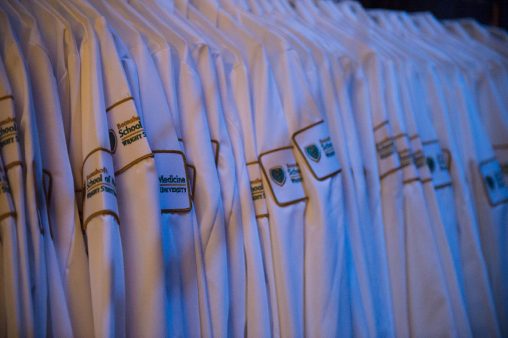
During the Boonshoft School of Medicine’s Convocation and White Coat Ceremony on July 9 entering students will take an oath of professional medical ethics and receive a white coat personalized with their name and the medical school patch.
The Wright State University Boonshoft School of Medicine will welcome 132 new students during a special ceremony on Saturday, July 9, formally marking the start of their medical education.
The School of Medicine’s annual Convocation and White Coat Ceremony will begin at 1 p.m. in the Wright State Nutter Center.
Tickets are required to attend. For ticket information, contact the Office of Admissions in the Boonshoft School of Medicine at 937-775-2934 or som-admissions@wright.edu.
The ceremony will be streamed live on the School of Medicine’s YouTube channel and Facebook page.
During the ceremony, students will take their first oath of professional medical ethics, concluding with the words, “I commit myself to a lifelong journey of learning how to cure, relieve and comfort with humility and compassion.”
Each student will receive a white coat, a traditional symbol of the medical profession, personalized with their name and the Boonshoft School of Medicine patch. Students will also receive a stethoscope, provided through donations from alumni, faculty and friends.
The Convocation and White Coat Ceremony represents an important milestone in each student’s journey to enter the medical profession. It also marks the first time the students will represent their status as a class and meet the faculty who will share, during the next four or more years, what may be some of the most memorable and intense experiences of their lives.
The new medical students will participate in orientation from July 6 to 8. Classes in the School of Medicine begin on July 11.
The students were carefully selected from a group of more than 7,600 applicants.
The class of 2026 draws from a variety of undergraduate experiences, and members of the class were educated at various universities throughout the United States.
In addition to Ohio, students come from 12 states and the U.S. Virgin Islands. The class includes students who were born all over the world, including Azerbaijan, China, Ghana, Greece, Iceland, Iran, Jamaica, Lebanon, Nigeria, Philippines, Russia, Saudi Arabia, South Korea and Syria.
Sixty percent of the students are women and 18 percent are from communities underrepresented in medicine.

 Bags, boards and bonding
Bags, boards and bonding  More than 1,000 students to graduate at Wright State’s fall commencement ceremonies
More than 1,000 students to graduate at Wright State’s fall commencement ceremonies  Wright State’s Take Flight Program helps students soar high
Wright State’s Take Flight Program helps students soar high  Wright State Police Department delivers major donation to Raider Food Pantry
Wright State Police Department delivers major donation to Raider Food Pantry  Wright State engineering and computer science students earn prestigious federal SMART Scholarships
Wright State engineering and computer science students earn prestigious federal SMART Scholarships 